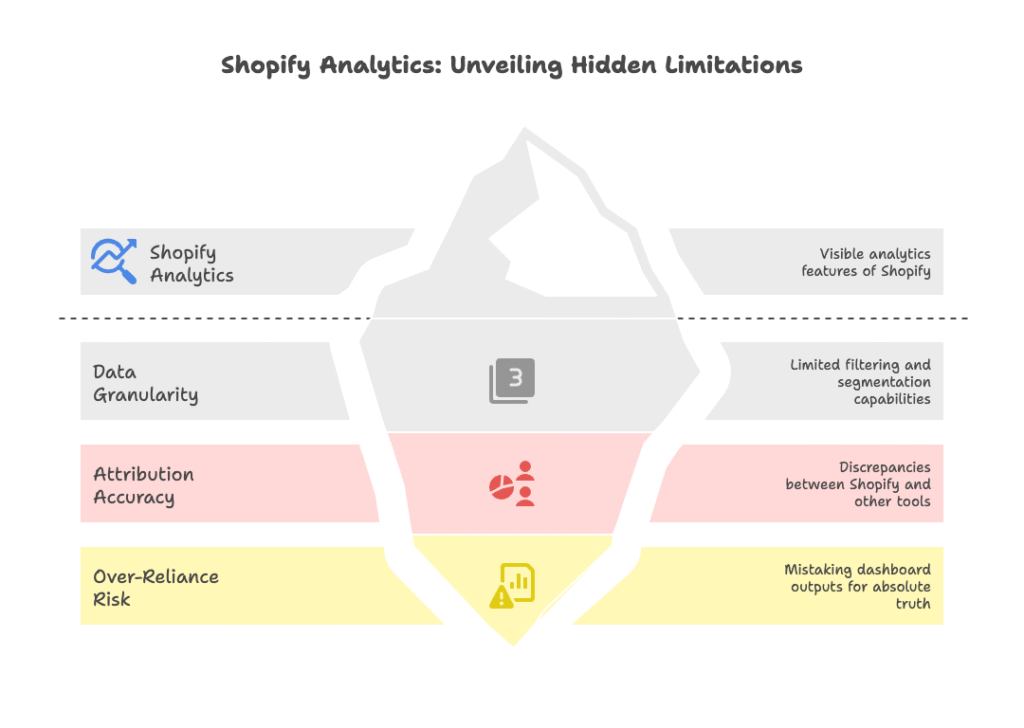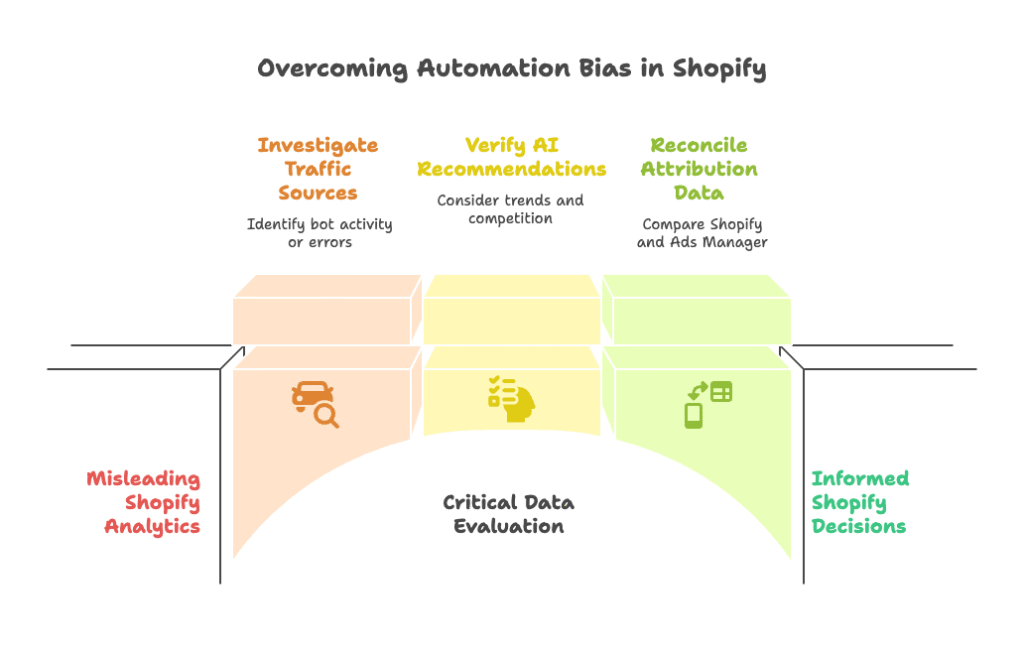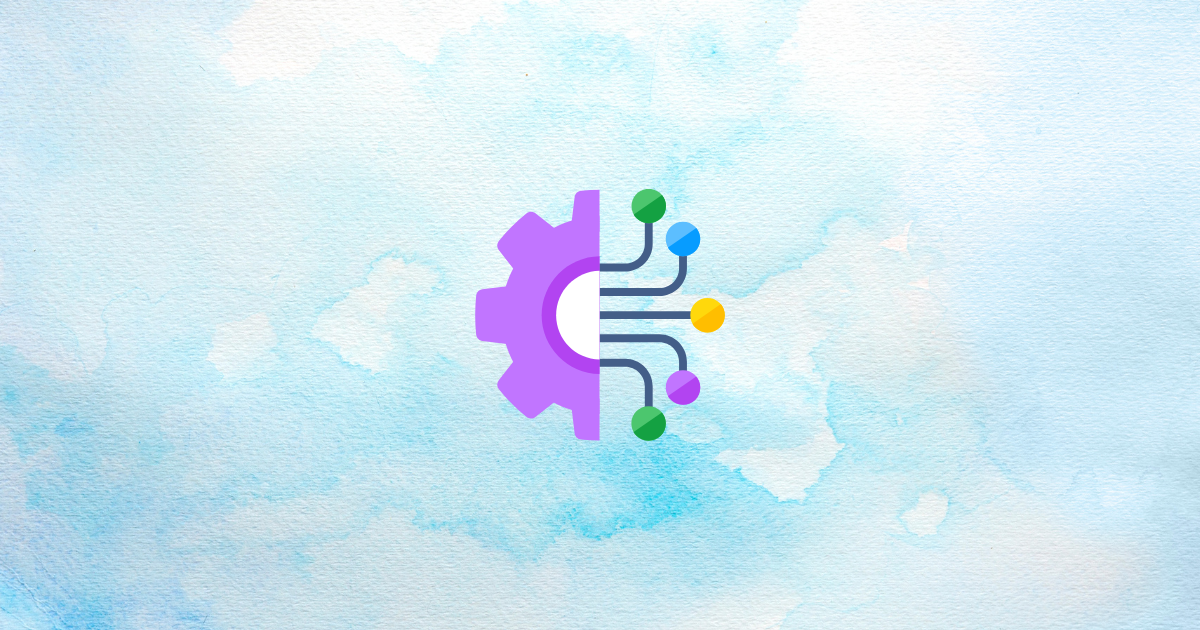Picture this: You wake up, grab your coffee, and immediately check your Shopify dashboard. Sales are up 15% from yesterday. Traffic looks strong. Your conversion rate hit a new high. Everything seems perfect.
But what if those numbers are lying to you?
In today’s e-commerce landscape, Shopify store owners have unprecedented access to data. The proliferation of analytics tools has transformed how we run our businesses, with seamless integration of dashboards, automated reports, and AI features becoming the norm. Every day, merchants rely on key metrics—sales figures, traffic patterns, conversion rates, and average order values—to guide their decisions.
This data-driven approach isn’t just helpful; it’s essential. Analytics have become the backbone of e-commerce strategy, especially as market saturation intensifies competition. The pressure to make informed decisions quickly has never been higher.
Yet beneath this technological marvel lurks a dangerous psychological trap: automation bias. This is our tendency to over-trust automated data or suggestions, even when they’re inaccurate. It’s the psychological comfort we find in delegating critical decisions to technology, assuming that complex algorithms know better than our human intuition.
For Shopify store owners, automation bias can lead to missed opportunities, misallocated budgets, and strategic missteps that compound over time. The very tools designed to empower us can become crutches that limit our growth. What we need is a marriage of data-driven strategies with sharp critical thinking—but that’s easier said than done.
Shopify Analytics: Capabilities and Limitations

What Shopify Analytics Brings to the Table
Before we dive into the problems, let’s acknowledge what Shopify does exceptionally well. The platform’s built-in analytics features provide comprehensive sales, traffic, product, and customer reports right within your admin dashboard. Live View gives you real-time glimpses into visitor behavior, while Insights surfaces trends automatically.
Then there’s the AI revolution. Shopify Sidekick and various analytics apps promise to surface trends, predictions, and recommendations that would take hours of manual analysis to uncover. These tools excel at identifying traffic spikes and monitoring sales performance instantaneously—a crucial advantage when quick responses can make or break a campaign.
The user-friendly interface deserves special mention. Unlike complex external tools that require technical expertise, Shopify analytics work right out of the box. No coding knowledge required. No separate login credentials to remember. Everything lives within the familiar Shopify environment, making data accessible to merchants of all technical backgrounds.
Perhaps most impressively, these tools provide actionable suggested insights. They’ll recommend inventory adjustments, highlight customer retention opportunities, and flag conversion bottlenecks automatically.
Where the Cracks Begin to Show
But here’s where things get complicated. Shopify’s analytics, despite their polish, have fundamental limitations that many merchants overlook.
Data granularity presents the first challenge. While Shopify’s reports cover the basics beautifully, they lack the filtering and segmentation capabilities of dedicated external tools. Try building complex KPIs or advanced funnel analysis, and you’ll quickly hit walls. The platform simply wasn’t designed for deep-dive analytics work.
Attribution accuracy creates another headache. Discrepancies between Shopify’s numbers and other tools like Google Analytics 4 or Facebook Ads Manager are common. Shopify uses basic attribution modeling that may not capture the full customer journey, especially for businesses with longer sales cycles or multiple touchpoints.
Then there’s the over-reliance risk—the heart of our automation bias problem. When merchants mistake dashboard outputs for absolute truth, they miss the nuanced reality behind the numbers. Data sampling, missed events, or incorrect tracking can skew results, but these issues often remain invisible to users who trust the automated reports implicitly.
Understanding Automation Bias in Shopify Analytics

The Psychology Behind Our Digital Dependencies
Why do smart, successful merchants fall into automation bias traps? The answer lies in basic human psychology and our need for cognitive shortcuts.
Running a Shopify store is overwhelming. You’re juggling inventory management, customer service, marketing campaigns, supplier relationships, and a dozen other moving parts. When faced with this complexity, our brains naturally seek the path of least resistance. Accepting “official” dashboards as infallible feels safer than questioning every data point.
This creates what I call the “set and forget” mentality. Merchants set up their default reports, establish routine check-ins, and make decisions based on surface-level data without digging deeper. It’s efficient in the short term, but dangerous over time.
When Automation Bias Strikes
Let me share some real-world scenarios where automation bias wreaks havoc:
The Traffic Spike Mirage: Your Shopify dashboard shows a massive 300% traffic increase overnight. Exciting, right? But what if that spike came from bot activity or a tracking error? Without investigating further, you might celebrate a success that never happened—or worse, make budget decisions based on inflated numbers.
The AI Recommendation Trap: Shopify’s AI suggests increasing inventory for a specific product based on recent demand patterns. You trust the algorithm and order accordingly. But the AI missed a seasonal trend reversal or failed to account for a competitor’s pricing change. Now you’re stuck with excess inventory and tied-up cash flow.
The Attribution Mismatch: Your Shopify reports show strong performance from Facebook ads, while Facebook Ads Manager tells a different story. Instead of investigating the discrepancy, you assume Shopify’s numbers are correct and increase your Facebook budget. The result? Wasted ad spend and confused campaign optimization.
The Ripple Effects of Bias-Driven Decisions
These individual mistakes compound into larger problems. Marketing budgets get misallocated when attribution data misleads you about channel performance. Inventory decisions go wrong when you trust unverified AI demand forecasts. Customer experience suffers when automated recommendations ignore outlier behavior or edge cases that require human judgment.
The most insidious part? These problems often remain invisible until they’ve caused significant damage. By the time you realize your decision-making process was flawed, weeks or months of suboptimal choices have already impacted your bottom line.
Critical Thinking Skills for Shopify Data Users
Building Your Defense Against Automation Bias
The solution isn’t to abandon analytics—that would be throwing the baby out with the bathwater. Instead, we need to develop critical thinking habits that complement our data-driven approach.
Always validate with context. This means comparing Shopify data with other analytics platforms regularly. Google Analytics 4, external BI tools, and even social media insights can provide different perspectives on the same events. When you spot unusual metrics or unexpected trends, investigate before acting.
Establish data verification procedures that go beyond automated reports. Use address verification tools for customer data accuracy. Implement order verification processes to catch fraudulent transactions. Schedule regular audits of your tracking implementation to ensure you’re capturing data correctly.
Most importantly, resist the temptation to rely exclusively on default insights. Customize your dashboards to track business-specific KPIs that matter to your unique situation. Train yourself and your team to ask “why” behind every number. A 20% conversion rate increase sounds great, but what caused it? Can you replicate it? Is it sustainable?
Marrying Human Judgment with Automated Analytics
The goal isn’t to replace AI with human intuition—it’s to create a partnership where each strengthens the other. Use AI as decision support, never as the sole authority. When Shopify suggests an inventory increase, filter that recommendation through your knowledge of upcoming seasons, competitor actions, and market conditions.
Invest in analytics literacy for your entire team. Cultivate healthy skepticism toward results that seem too good to be true. Encourage data-centric experimentation through A/B testing, where you can validate assumptions with controlled experiments rather than hoping automated insights are correct.
Advanced Strategies to Overcome Automation Bias
Building a Multi-Tool Analytics Ecosystem
Sophisticated merchants don’t rely on Shopify analytics alone. They integrate Google Analytics 4, specialized tools like Piwik PRO, and business intelligence platforms to triangulate data sources for accuracy and deeper insights.
This approach reveals discrepancies that single-source analytics miss. When backend-confirmed sales don’t match behavior tracking data, you know there’s a problem to investigate. When multiple tools agree on a trend, you can feel more confident in your decisions.
Server-side and cookieless tracking solutions add another layer of reliability. These technologies minimize data loss from ad blockers and privacy changes while ensuring enhanced compliance with GDPR and CCPA regulations. They provide a more complete picture of customer behavior, especially as privacy-first browsing becomes the norm.
Data Governance in the Privacy Era
Modern analytics strategies must balance accuracy with compliance. This means configuring consent management systems properly and implementing privacy-first reporting that respects customer preferences without sacrificing insight quality.
Consider data ownership carefully. Platforms that keep analytics data within your control offer more flexibility and reduce vendor dependence. When you own your data, you can migrate between tools, create custom analyses, and avoid the lock-in effects that limit strategic flexibility.
Custom Reporting for Deeper Understanding
The most sophisticated approach involves building custom dashboards using Shopify APIs and SQL-enabled apps for complex queries. This might sound technical, but many third-party tools make it accessible to non-programmers.
Mixed-method analysis—combining quantitative data with qualitative insights—provides the richest understanding of your business. Customer surveys, support ticket analysis, and competitive intelligence add context that pure numbers can’t provide.
Scenario planning and predictive modeling help you prepare for different outcomes rather than reacting to automated alerts. When you understand the range of possibilities, you’re less likely to be blindsided by unexpected changes.
Practical Next Steps for Shopify Store Owners
Auditing Your Current Analytics Practices
Start with honest self-reflection. How many of your recent major decisions were based solely on Shopify analytics without cross-validation? Do you routinely question automated recommendations, or do you accept them at face value?
Create a checklist for automation bias detection. Before making significant decisions, ask yourself: Have I verified this data with another source? Does this recommendation align with my business knowledge? What could explain this trend besides the obvious interpretation?
Ensure ongoing training and literacy development for yourself and your team. Analytics tools evolve constantly, and your understanding should evolve with them. Regular training sessions, even brief monthly reviews, can dramatically improve decision-making quality.
Creating a Balanced Analytics Environment
Integration doesn’t happen overnight, but you can start small. Add Google Analytics 4 if you haven’t already. Experiment with one additional analytics tool that provides a different perspective on your data. Schedule monthly reviews where you compare insights across platforms and investigate any significant discrepancies.
Document your findings and update your standard operating procedures around data verification. When team members know the process for questioning and validating analytics insights, the entire organization becomes more resilient against automation bias.
Fostering a Culture of Informed Skepticism
The most successful change happens at the cultural level. Encourage team discussions about data insights. Make it safe to question automated recommendations. Reward thoughtful questioning and evidence-based decision-making rather than just following the numbers blindly.
This doesn’t mean becoming paralyzed by analysis—it means becoming more thoughtful about which analyses deserve your trust.
Trust, But Verify—A New Mindset for Shopify Analytics
The future of successful e-commerce belongs to merchants who can harness the power of automation while maintaining critical thinking skills. Shopify’s analytics tools will only get more sophisticated, and AI recommendations will become more persuasive. This makes human oversight more important, not less.
The goal isn’t to eliminate automation bias entirely—that’s probably impossible. Instead, we need to develop systems and habits that catch our biases before they lead to costly mistakes. We need to trust our tools while verifying their outputs, embrace AI insights while maintaining healthy skepticism, and automate our processes while preserving human judgment where it matters most.
The merchants who master this balance will have a significant competitive advantage. They’ll make faster, more accurate decisions. They’ll waste less money on ineffective strategies. They’ll spot opportunities that others miss because they’re not blinded by automated assumptions.
Your analytics should empower you, not replace you. When you combine the best of automated insights with thoughtful human analysis, you create a decision-making process that’s both efficient and reliable. That’s the foundation for sustainable, long-term success in the competitive world of e-commerce.
References
- Shopify. “AI Customer Experience: 11 Strategies for Business Success in 2025.” https://www.shopify.com/blog/ai-customer-experience
- Haydon Power. “The Future of AI in Shopify Stores & Development.” https://haydonpower.co.uk/blogs/resources/the-future-of-ai-in-shopify-stores-and-development
- Saras Analytics. “Shopify Analytics Dashboard: A Comprehensive Guide (2025).” https://www.sarasanalytics.com/blog/shopify-analytics-dashboard
- Praella. “Ensuring Accuracy: A Guide to Shopify Data Verification.” https://praella.com/blogs/shopify-insights/ensuring-accuracy-a-guide-to-shopify-data-verification
Ready to supercharge your Shopify store’s sales with perfectly optimized discount strategies that go beyond basic analytics? Growth Suite is a free Shopify app that uses AI-powered behavioral tracking to predict purchase intent and deliver personalized, time-limited offers only when they’ll drive conversions—not erode your margins. Unlike generic discount tools, Growth Suite helps you make data-driven decisions about when, how, and to whom you offer discounts. Install it with a single click and start seeing results while maintaining the critical thinking approach this article advocates!




